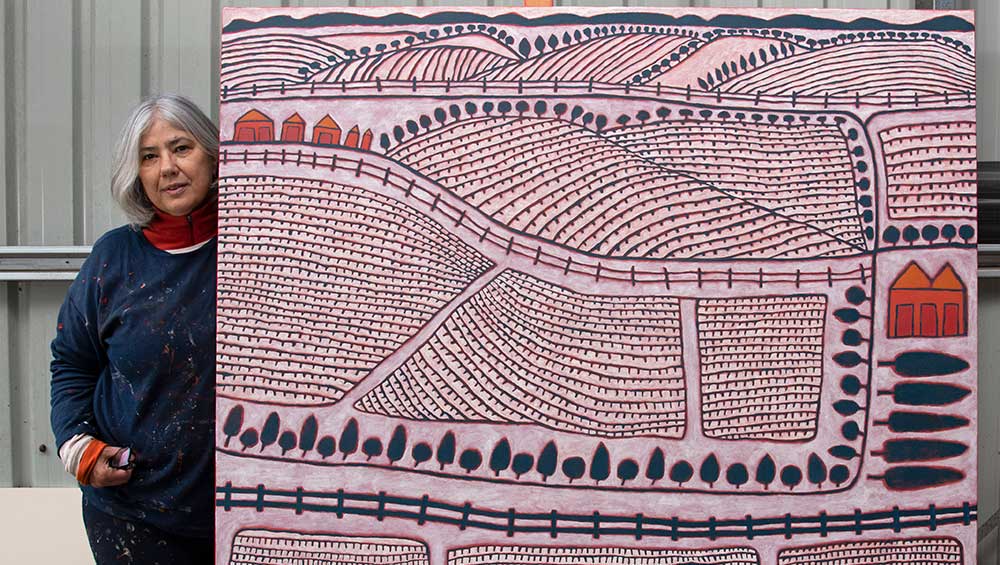
Marina Strocchi. Photo: Viki Petherbridge.
by JANET McKENZIE
Marina Strocchi’s art is immediately recognisable and although numerous visual influences from the work of Paul Klee, Pablo Picasso, Joan Miró, Jean Dubuffet, Alfred Wallis and Henri Rousseau have been absorbed throughout her 40-year career, as well as non-western art and craft traditions, they are absorbed into her own distinctive visual language. The paintings sometimes appear as pictographs, apparently naive, yet confidently structured, based in an ever-inventive imagination and informed by a personal and intuitively driven intellect. An inveterate traveller and widely read from an early age, Strocchi developed an interest in other cultures, fuelled by political indignation at suffering and injustice. Although she took a trade-oriented course at Swinburne Technical College in Melbourne, where she studied graphic design, acquiring commercial-level expertise in silkscreen printing, she also loved life drawing. While still a student, she sought out the company of other artists in Melbourne, primarily those from the Roar Studios co-operative: “Out of a visual curiosity and wonder, I looked at them in them in their studios, as I had done my art teacher, and a seed was planted.”1
Although reluctant to talk about her own work, she describes paintings by Aboriginal artists with whom she has worked from an original stance and with insight and alacrity. Her work can be seen to capture the mysterious, complex and dichotomous nature of the world, of beauty and of injustice.
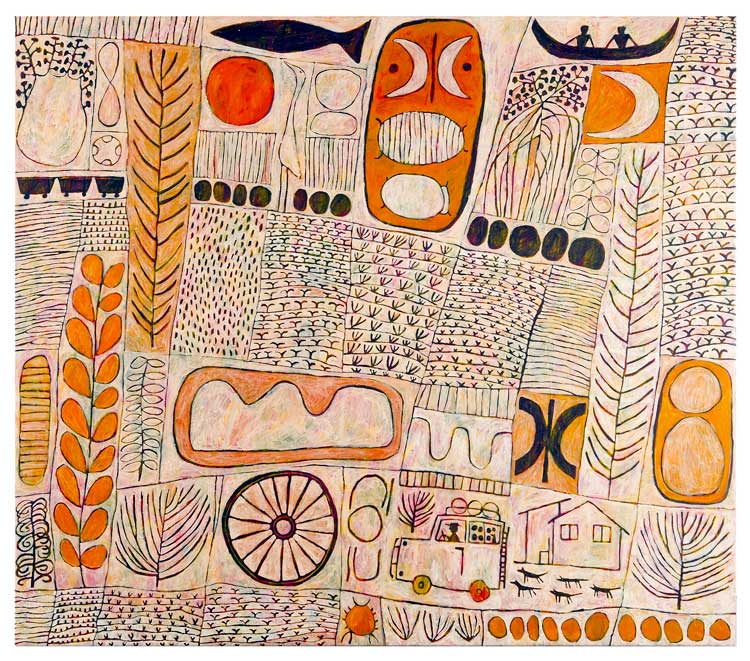
Marina Strocchi, Out Bush II, 2007. Acrylic on linen, 175 x 200 cm. © the artist.
Strocchi was born in Melbourne in 1961 to an Italian father and a third-generation mother of British and German descent. Originating from the Emilia-Romagna region of Italy, her father, Giacomo Strocchi, was passionate about politics and was also a key figure in the Brooks Crescent protests that sought to stop plans to demolish period houses in Melbourne and replace them with high-rise public housing.2 He fought with the Italian partisans during the war and was decorated for bravery, but the war took its toll, and as with many refugees and migrants to Australia, the trauma was played out in family life and was witnessed by his children.
The second world war and the influx of a wide range of new blood transformed art and politics. There were numerous opportunities in postwar Melbourne for radical politics, at every level of society. Noel Counihan (1913-86) had witnessed first-hand the impact of the depression in the 1930s and became a social realist artist and life-long Communist party member. Josl Bergner (1920-2017), who was born in Austria and grew up in Poland, came to Melbourne in 1937 where he stayed for 11 years before moving to Israel: he saw in the wretched plight of Aborigines in society a parallel with the persecution and dispossession of the Jews by Hitler. Counihan observed: “Bergner identified with the Aborigines. He saw them from a Jewish standpoint and painted them as Jews. He stepped across the gap and identified with members of another oppressed race.”3 Bergner used art as a means to highlight inequality and prejudice in Australian society with deeply compassionate images of Aborigines. As late as 1946, the magnitude of the Holocaust was uncovered in newsreels in Melbourne, which led artists to express their outrage and horror: Arthur Boyd created compelling images of war through Old Testament narrative set against the Australian bush; his compassion was expressed through images of amputees in Melbourne streets. Counihan, committed as he was to social-realism and caricature, was arguably the most overtly political of Australian artists of the 20th century. The ardent legacy of numerous artists of this period, in addition to the prescient contribution of refugees and migrants, led to a rare sensibility and insight into social issues, especially the innocent victims of war and the plight of the underprivileged. Australian society experienced an intellectual coming of age during and after the war and an unprecedented artistic power was asserted.
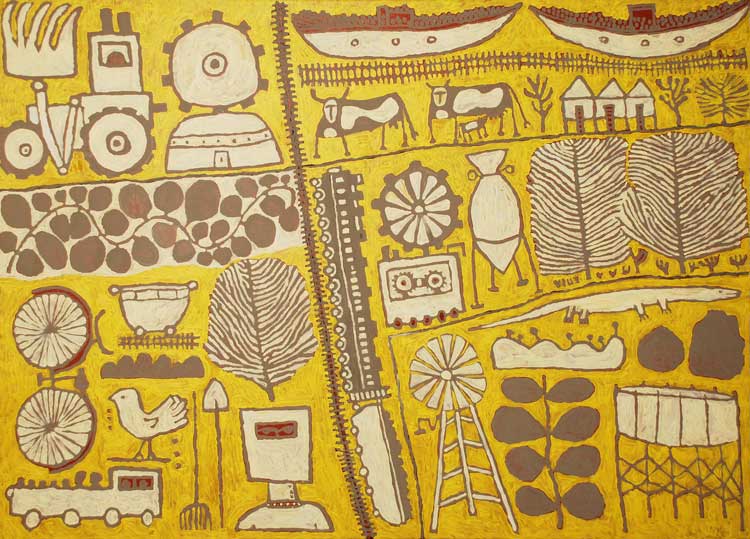
Marina Strocchi, Big Country, 2007. Acrylic on linen, 86.5 x 109 cm. © the artist.
By the 1950s and 60s, the children of politicised Australians, and those of traumatised refugees and migrants experienced relative prosperity, but they were also sensitive to the complexity of their inheritance. The impact of this generation is inestimable and is responsible for many of the most important cultural and intellectual developments and stellar achievements in the art world in Australia since. Strocchi’s independent path as an artist and the first art coordinator of the Ikuntji Art Centre at Haasts Bluff (1992-1997) was necessarily born of a plethora of complex factors. Her father’s larger than life presence impacted her emotional development and his politically charged behaviour meant she could not turn her back on society’s ills. Her mother, Nona May’s example, and creative attitude within their home life showed a creative means of building a fulfilling, resilient life.
Strocchi’s dedication to the arts as a tool for the betterment of humanity shares Counihan’s politically charged example, although hers was intuitively sought. From 1984 to 1987, while in her early 20s, she travelled extensively, to Europe where she visited museums, churches and galleries and explored family roots (Italy, France, Spain, England) and to the US and Mexico. Back in Australia and with a growing awareness of how art could be a force for good, and possessing both empathy and curiosity, she was persuaded by friends to visit Central Australia. The inspiring achievements of the Papunya Tula Artists’ Company, established in 1972, and other projects that were developing, particularly those for women, led to her decades-long commitment towards empowering the lives of First Nations people through art. She is quick to point out that her motives were not intentional: “It’s only looking back that one could say this – I did come up against naysayers – people who wanted to see failure and restrict painting to men, but I listened to the First Nations people and was supported by Wayne Eager, who had experience from Roar Studios and growing up with parents who were artists.”4
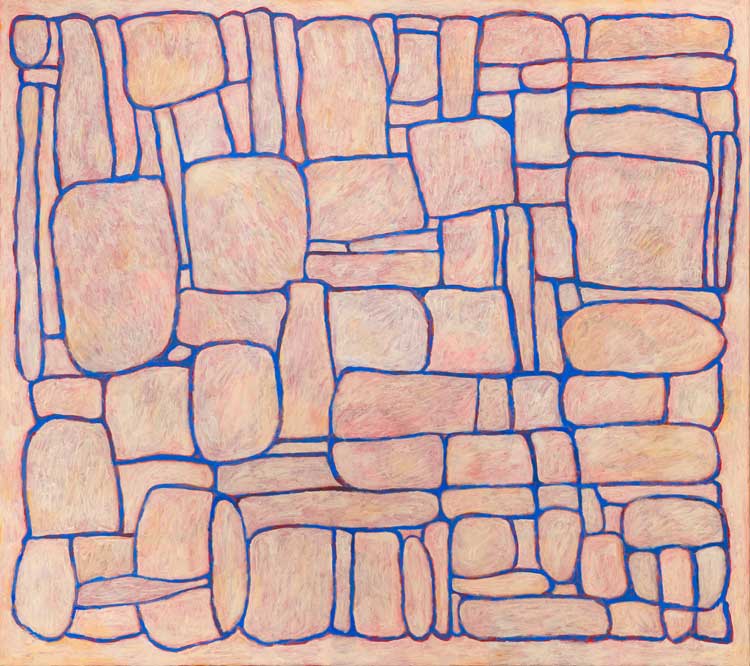
Marina Strocchi, Blue Drawing II, (2003-2018). Acrylic on linen, 122 x 137 cm. © the artist.
In 1995, Strocchi published Ikuntji: Paintings from Haasts Bluff 1992-94 and, in 1998, curated Ikuntji Tjuta, a major exhibition of the work from the Ikuntji centre, and she worked as a field officer for Papunya Tula in 1999. After this, she conducted painting workshops throughout the states of the Northern Territory, South Australia and Western Australia. The National Gallery of Victoria exhibition Across the Desert: Aboriginal Batik from Central Australia, curated by Judith Ryan, the leading scholar of Indigenous art in Australia, was reviewed for Studio International in 2008. Strocchi’s essay for the exhibition, Before Painting: The Kintore Batiks, tells the fascinating early story. More revealing of the incredible work she achieved in human and cultural terms is the comprehensive essay Family Connections: Walungurra Women in Action, for the 2021 publication by the Kluge-Ruhe Aboriginal Art Collection of the University of Virginia, US: Irrititja Kuwarri Tjungu | Past & Present Together: Fifty Years of Papunya Tula Artists.5
All publications are accompanied by her invaluable photographic documentary. In 2021, after 29 years in Central Australia she returned to Melbourne. Her contribution on professional and personal levels to the artists she worked with is inestimable. Contemporary Indigenous art in Australia is a unique international phenomenon and represents the longest living culture of more than 60,000 years.
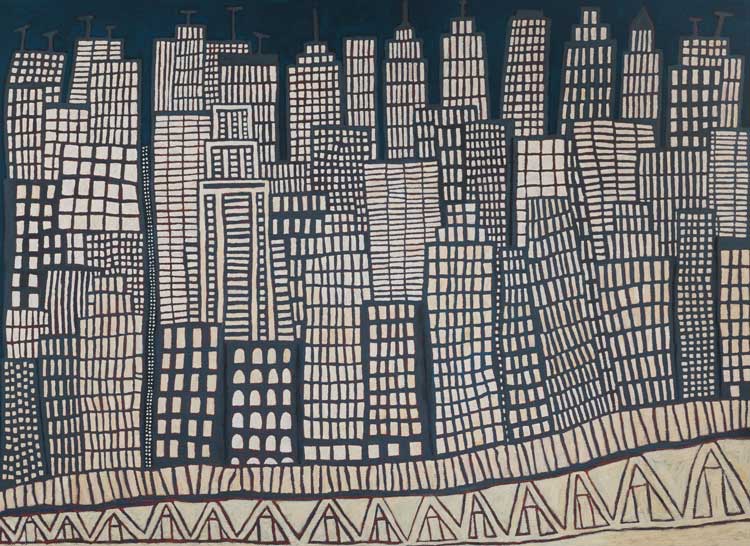
Marina Strocchi, New York (linen), 2020. Acrylic on linen, 122 x 167 cm. © the artist.
Marina Strocchi spoke to Studio International by Zoom and by email from her studio in Melbourne.
Janet McKenzie: When did you first become aware of the extent of the legacy of colonial abuse and its impact on living First Nations people?
Marina Strocchi: As a child, I saw ABC television programmes Four Corners and A Big Country. As a family, we watched news and informative documentaries. I remember footage of what was most likely the Wave Hill Walk-off, and also footage of possibly Papunya or another government settlement in the desert. So, most likely this black-and-white newsreel footage was my first visual information. When I was a child, we would camp at Lake Tyers and, across the lake, there was a community of First Nations people – sometimes, I would see them around the shops, looking like outsiders. I think I was woefully uninformed; it just made me feel uncomfortable. My family went to Australian Labor party fundraisers for Gough Whitlam and one night we were on the same table as Pastor Sir Douglas Nicholls [Australia’s first Indigenous state governor] and his wife and I remember they were very elegant and quietly spoken. It was only when I went to visit, then live at, Haasts Bluff that I realised how dire the situation was. I’d say I was naive up until then.
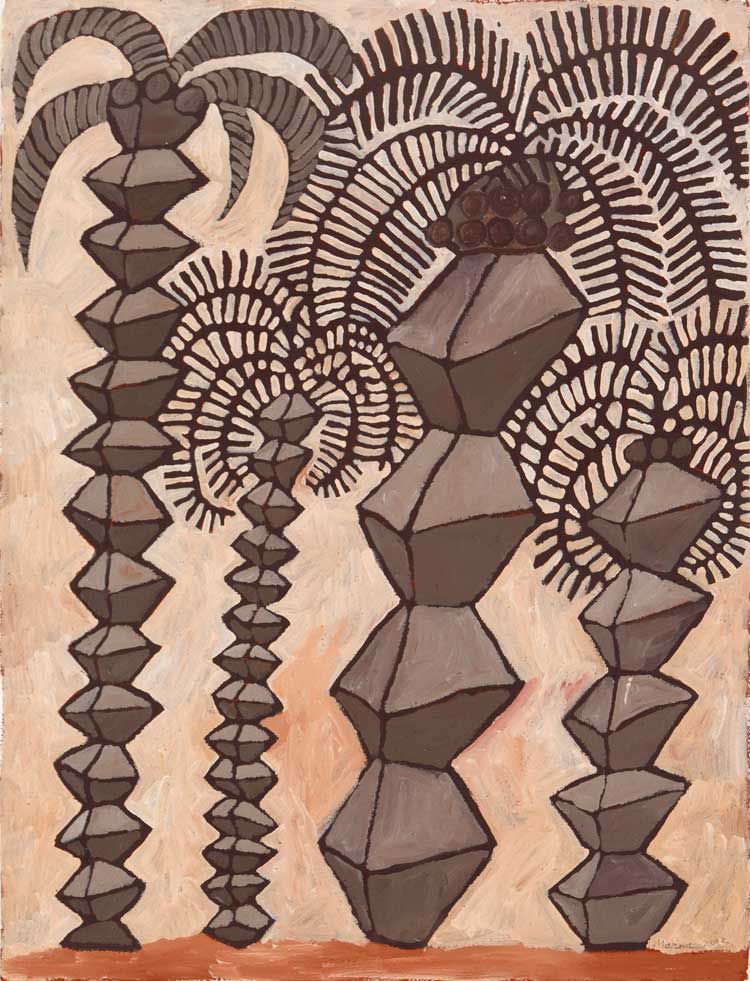
Marina Strocchi, Brancusi Palms, 2003. Acrylic on paper, 76 x 57 cm. © the artist.
JMcK: When did you first see work from Papunya Tula?
MS: At the Government Gallery in Bourke Street, Melbourne, in the 1980s. But the first time I was moved by a contemporary Indigenous work was in 1986. Judith Ryan had a small area of space at the top of the escalators at the National Gallery of Victoria in Melbourne and I saw a Johnny Warangkula Tjupurrula painting, A Bush Tucker Story (1972), that moved me. The gentleness of the brushstrokes, the sensitive colours, the intense love that went into the work affected me. The other ones were pretty good too. Shorty Lungkata Tjungurrayi is my favourite.
JMcK: When you saw for yourself the transfer of centuries’ old living culture from (ephemeral body painting for sacred ceremonies) to paintings on linen or paper, did it feel momentous?
MS: It was already happening at Balgo, Papunya and Yuendumu. I arrived, with my partner, Wayne Eager, in 1992, long after the transfer had started. What was momentous was that the works that we had seen together in reproduction and in exhibitions, such as the first Mick Namarari solo exhibition at Gallery Gabrielle Pizzi in Melbourne, I had seen before going to Central Australia was done by the very first people we met and those we subsequently worked with. After Wayne worked at Haasts Bluff, he worked for Papunya Tula for four years full time and then intermittently after that until we left the Northern Territory. That was amazing. It was amazing to think that they were just walking around – it was a red carpet. We met many of the top male artists with whose work we were very familiar – and we knew their faces from books. Everything felt momentous, especially when people we knew were dying and when we bore witness to the first contact people dying, one by one. It felt like the momentousness was in the 11th hour of those who had witnessed another way of life – as it had been lived – was slowly ebbing away. New life followed and people adapted.
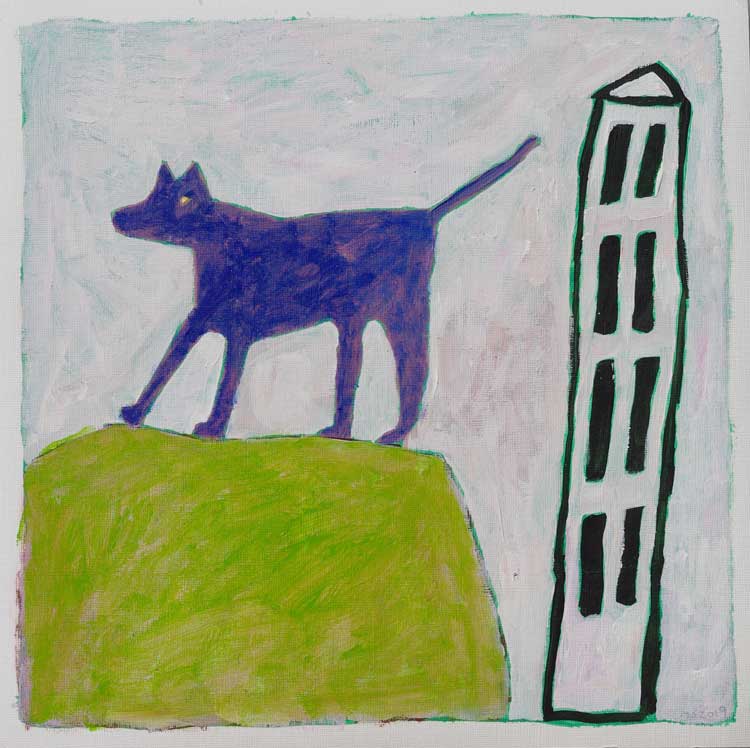
Marina Strocchi, Tower and dog, 2019. Acrylic on paper, 33 x 33 cm. © the artist.
JMcK: Did it feel that enabling art production on western materials would become hugely important to artists within Australia and internationally?
MS: The recognition was already happening at Papunya Tula – the interest in the early boards exploded while we were at Haasts Bluff (1992-1997). Sotheby’s created a buzz around the early work. I was unsure of everything, though we had a feeling that it would expand to the level that it has today. We had an intuitive instinct that more was to come. Wayne was surer that this was solid, grass roots, good painting. We just kept at it – and it grew slowly, and I am pleased to say that the Ikuntji Art Centre is still a place of innovation with the younger generations now working. I photographed all the work from the beginning and recorded it all. There was a sense that it was important, but as is in the desert, it also felt it could fall in a heap at any moment, as there were many factors working against it. Regarding the women’s work (described in the essay for Kluge-Ruhe), I knew it was an important moment – I filmed the painting camps, took lots of photos and kept notes. I knew that it was a moment. But nothing is guaranteed with paintings. I got negative feedback from people outside the community for even talking about the project. There was a thing about Papunya Tula being a men’s company … it’s all in that essay. I knew the Kintore project was the most important project I had done or would do, apart from my own work, which is only important to me. It was the fact that the women had been wanting to paint for years and I saw that they saw painting as part of cultural maintenance, in that it was a way of keeping their stories and songs ever present, plus their work was collected and they travelled interstate or eventually some artists exhibited in New York.
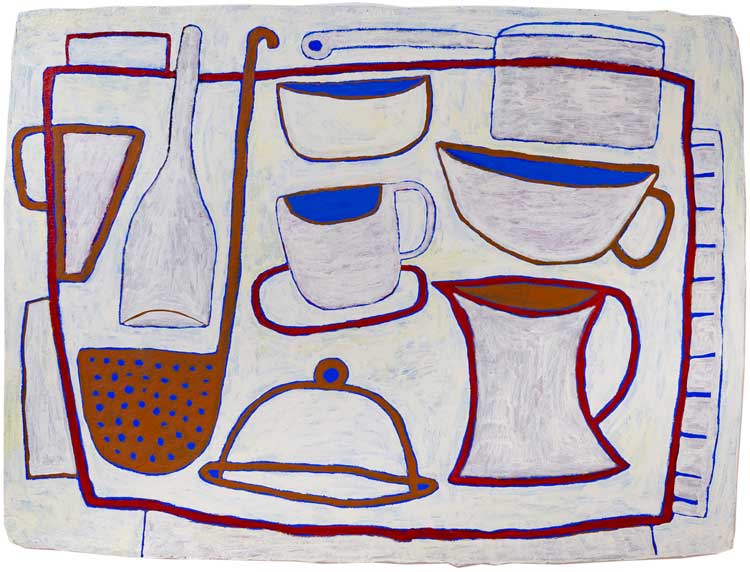
Marina Strocchi, Still Life, 2019. Acrylic on paper on marine ply, 60 x 80 cm. © the artist.
JMcK: Did you expect to spend almost half your life working in Aboriginal arts centres in the Northern Territory?
MS: I did maintain a 29-year connection to working with First Nations artists, but from 1992 to 2002 it was pretty well full time. After that, it was for specific projects or regular workshops, and I balanced this work with my own work. I thought I was going up to the Northern Territory for three months. When we arrived, I was told by the community adviser that it was, in fact, six months. By then it was too hard to leave what had developed in that time. It felt that people were just getting into their stride. You have to paint quite a lot every day before you crack the code and that is your unique code. People had to find their own voice in paint. Time went by very quickly: we always felt Melbourne was our hometown and we travelled home often. The first 10 years was an all-consuming experience. Once we got a house and studios in Alice Springs, there was more balance.
.jpg)
Marina Strocchi, Bright, sunshiny day (state II), 2020. Acrylic on linen, 114.5 x 119 cm. © the artist.
JMcK: Can you describe a typical day at Haasts Bluff in 1992?
MS: Chaotic or quiet, never anything in between. It was very busy; my feet would get hot from running around, and the phone rang and rang. People went to the art centre for all their needs not just to paint. It evolved over the years. Initially, we started off on three-ply offcuts from a timber supplier. We ordered in paper and linen pretty quickly. From the get-go, it was always about the painting – we published a bilingual book of paintings in 1995. We also did screen-printed T-shirts and fabric, which was for anyone who was interested, as was the painting. The painting gathered its own momentum. It was a community fraught by its relative closeness to Alice Springs so there was a lot of coming and going.
JMcK: You contributed an essay to the catalogue that accompanied Across the Desert: Aboriginal Batik from Central Australia, about the role of batik fabrics taught to female Aboriginal artists, and how they predated the paintings that later achieved huge recognition. Can you describe the role you and batik fabrics played in the artists’ subsequent careers?
MS: The funny part of that story was that, on a visit to Kintore in 1995, I popped into the women’s centre and noticed a pile of waxy fabric in the corner with a dog sleeping on the top. I tugged at a piece and saw that it was a really good design.I asked lots of questions and, as I was already known to the women, I suggested getting the wax out and showing them to Judith Ryan. I had to investigate how to do this with chemicals and then figure out who did which ones. I photographed them and they were bought by the National Gallery of Victoria through the Ikuntji Art Centre. It was around the time we were preparing for the big canvas project. The mark-making was free and spontaneous. It was very inspiring. I had seen similar mark-making in the murals at the Kintore Ngintaka Women’s Centre, but they later were painted over – although not before I photographed them. They were the closest things I have seen to cave painting; the wax was applied with biggish brushes, so it had none of the daintiness found in the Ernabella Art Centre’s Indonesian batik method tool work. The women who had done these batiks also participated in the Haasts Bluff/Kintore project and then, in April 1996, started with Papunya Tula, which coincided with Wayne’s employment there. They were the older women from Kintore, who were concerned with singing and maintaining cultural practices that included ceremonies and dancing and they saw painting as a natural mode of cultural expression.
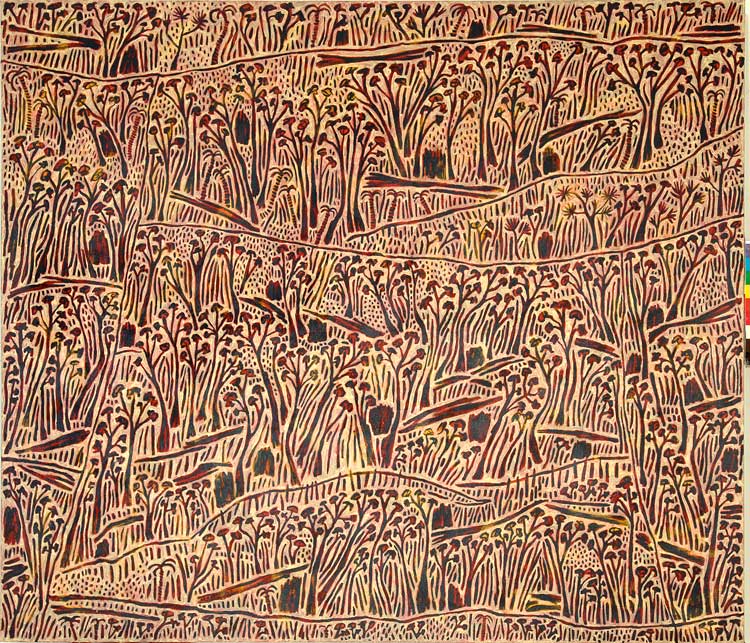
Marina Strocchi, Burn Off, 2007. Acrylic on linen, 183 x 212 cm. © the artist.
JMcK: You were involved with all aspects of life with the communities, including funerals and their grieving processes. That must have been intensely challenging for a young person who had grown up in the city. Is it possible to explain the bonds you developed?
MS: The funerals were far too frequent and sometimes were from inexplicable tragedies. I had never known so much grief and so many funerals. I had never experienced the full throttle wailing that occurs: it is quite cathartic. People go into a zone of wailing and there is a lightness that comes afterwards. I thought they really knew how to do funerals properly. They also sang these Lutheran hymns in Pintupi/Luritja. They were sung slowly and in slightly staggered harmonies, sometimes with a cheap electric organ. It was the saddest music you could imagine, not just for funerals either. They do gospel singing every night, with the addition of guitars too. We knew some fine musicians over the years. Bonds came from friendships – I had my mates, we’d go camping for the weekends, hunting. I loved going to Kintore where I had mates too.
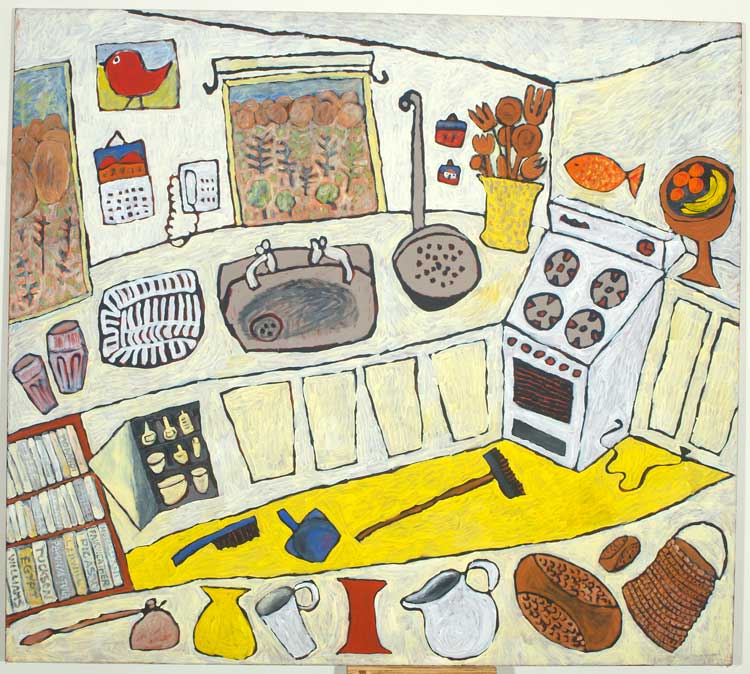
Marina Strocchi, The Kitchen, 2002. Acrylic on linen, 122 x 137 cm. © the artist.
JMcK: Your own painting and printmaking have absorbed a palpable wonderment for place, the mystery of life, and the spiritual richness of the art of First Nation Australians, but it is very much your own. Has it been harder to assert your own needs as an artist while enabling others for such a significant part of your life?
MS: Very early on I was disgruntled about being the lackey while everyone including my partner were painting. Wayne said: “Just start and keep going.” So, I did start and even though I was very busy, there were also quiet times like long weekends. I painted in the evenings and lunchtimes; I grabbed time when I could. I had to carve time for myself. We would go out for a drive in the early evening and take sketchbooks, which gave me a good grounding in looking at the landscape. My first few exhibitions I paid homage to the landscape, in my own way – paying attention to details. After a while, I felt impatient to break out of that homage and I moved into a more linear way of painting and developed a sort of personal set of hieroglyphics to tell stories. The imagery and methods that I experimented with in printmaking in the 1980s sort of came back to me in the paintings. I like to work in series of works – either mini-series or ones that go on for years. I decided to quit any regular employed work to focus on my own, although, all the way through, I still did workshops in the bush or most recently in town. It’s very satisfying to paint and equally satisfying to see someone else paint – it’s like listening to music. It felt like a privilege to work for people who wanted to paint. It is hard to do it full time, year after year. Some people manage but they might do half in town/half out bush. It feels like a privilege to do my own work. I’d go back and do workshops or a project if I was asked to.
References
1. Email from Marina Strocchi to Janet McKenzie, 31 October 2022.
2. These protests have widely been credited with ending the Housing Commission of Victoria’s approach to “slum clearance” by replacing low-density housing in favour of high-rise building.
3. Interview with Noel Counihan by Janet Mckenzie, 31 August 1985. In Noel Counihan by Janet McKenzie, Kangaroo Press, Sydney, 1986.
4. Email from Marina Strocchi to Janet McKenzie, 31 October 2022.
5. The book and exhibition reveals much of Kluge-Ruhe’s collection of 2,200 objects that has never been published. The exhibition at Kluge-Ruhe is open until February 2023, then travels to the Embassy of Australia in Washington DC. See also the 2018 interview in Studio International, Henry Skerritt and Margo Smith talk about the Kluge-Ruhe Aboriginal Art Collection.
See also:
Papunya painting: out of the desert
Aboriginal women as ambassadors of art and culture
Utopia: the genius of Emily Kame Kngwarreye
The Triumph of Painting
Who Are You: Australian Portraiture
Damien Coulthard: Songlines XXX, Adnyamathanha Yarta – ‘It’s exciting when you feel a connection with ancestral lands’
art + soul
Colour Country: Art from the Roper River